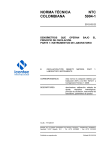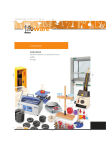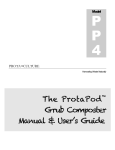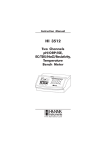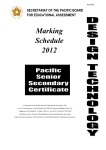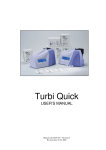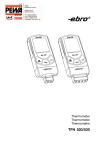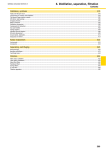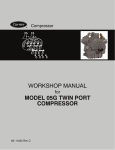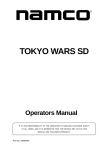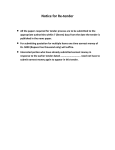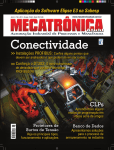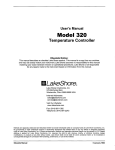Download Summary of the product lines
Transcript
AUXILAB LABORATORY SUPPLIES index of contents 03 hydrometry 04 thermometers page 5 page 6 01 glass 02 porcelain & agate pages 2-3 page 4 06 labware 07 liquid handling page 8 page 9 11 centrifuges 12 molecular biology page 13 page 14/17 AUXILAB SPECIAL: ”The centrifugation“ pages 18/21 electrophoresis thermal cyclers AUXILAB SPECIAL: ”Polymerase chain reaction PCR“ 16 17 refractometers 05 educational purposes page 7 08 balances 09 stirrer & shaker 10 ovens & heating mantles pages 10/11 page12 13 spectrophotometry 14 histology 15 microscopes page22/23 page 24/26 microtomes AUXILAB SPECIAL: ”Sample processing for microscope“ page 27/28 pH meter & conductimeters pages 29/30 page 31/32 _auxilablaboratory supplies Glass is a transparent and inorganic material, relatively inert and high thermal resistant, being ideal for making most common use lab tools in any scientific field. Our catalogue offers a wide variety of glass tools make of soda glass or borosilicate glass, in addition to a wide range of volumetric material. borosicilicate glass Present boron oxide in its composition which confers excellent chemical and physical properties. It presents and extreme chemical resistance with sustances like water, saline solutions, acids, bases and organic solvents being attacked by hydrofluoric acid at high temperatures, by strong bases and concentrated phosphoric acid. It presents a very low expansion coefficient so it resists temperature changes and high heats maximum 500ºC for short periods of time. Therefore, borosilicate glass is ideal in every applications that requiered very good chemical resistance, a high thermal resistance, temperature changes in adition to high mechanical stability. In our borosilicate glass offer, you can find bakers, funnels, ISO bottles and all kind of flasks (Erlenmeyer, filtering, spherical and distilling flasks). [Distilling flask and Erlenmeyer flasks] Approximate chemical composition of borosilicate glass Formula Name % Weight SiO2 Sílice 80.4 % B2O3 Boron oxide 13 % Na2O/K2O Sodium/potassium oxide 4.2 % Al2O3 Aluminum oxide 2.4 % [Crystallizing dishes with spout and Petri dishes] soda glass It presents good chemical and physical properties, being suitable for those products that normally have only to resist chemical efforts for a short period of time and they don´t have to bear thermal loads. We offer a wide range of crystallizing dishes, funnels, different tipes of bottles, staining jars, desiccators and several sizes and capacities mortars. [Mortar and Hellendhal jar] [Wide neck bottles and dropping bottles with glass tube] auxilab glass 02 _auxilablaboratory supplies OUR ADVICE FOR BETTER CLEANING OF GLASS Laboratory glassware can be cleaned manually in a immersion bath or automatically in a laboratory dishwasher. Before using, we recommend rinse laboratory glassware to remove transport dirtiness. A universally known method is wash with a soaked washing up liquid scourer or a sponge. Laboratory glassware must not be treated with abrasive agents as it might damage the surface. In the procedure of immersion bath, laboratory glass are submerged into a washing up liquid solution at room temperature for 20 or 30 minutes, after this, rinse with water and finally with distillated water. It is recommended not exceed action time or increase temperature, except in case of persistent impurity, that is the reason it should be avoided long time of exhibition at higher temperatures than 70ºC in alkaline element, because this can destroy the graduations. volumetric glass Volumetric glass referes to a serial of glass containers measured at a temperature of 20ºC to contain very precise liquid volumens. There are two tipes of calibration for volumetric glass, it depends on the glass instrument. Calibration to contain (In): contained quiantity of liquid corresponds exactly to the capacity indicated on the instrument, (e.g. volumetric flasks, cylinders.) Calibration to deliver (Ex): delivered quiantity of liquid corresponds exactly to the capacity indicated on the instrument (e.g. pipettes and burettes). We offer different volumetric material like graduated flaks, cylinders, pipettes or burettes class “A” or “B” depending on their tolerance range or maximum error limit. Class “A”: volume tolerances are within the limits defined by ISO and DIN. Class “B”: volume tolerances are within twice the limits of class A defined by ISO and DIN. [Graduated measuring cylinders and class A volumetric flasks] [Fractional distillation equipment and García Tena equipment for acidity determination] glass with ground joint We offer a wide variety of material made of borosilicate glass that presents interchangeable conic ground joints for required mounting assemblies to carrying out numerous chemical reactions. Ground joints are designed by two numbers that refer to the main diameter auxilab glass [Soxhlet extractor] and length of the joint. In our catalogue you can find goods like flasks, condensers or most common sizes of bent pieces (14/23, 19/26, 29/32 or 45/40), in adition to complete distillation equipment for simple or fractional distillation, Soxhlet extractors and semi micro equipments for making lots of mounting aseemblies. 03 _auxilablaboratory supplies Several routine applications in a laboratory require the use of instruments and tools made of inert materials with special characteristics as good thermal resistance or a high hardness; in these applications it is not possible to use glass products so it is necessary to use items made of other materials such as porcelain or agate. porcelain Made by firing a mixture of natural minerals (china clay, quartz and feldspar), laboratory porcelain is an impervious silicate material with a low thermal expansion coefficient and therefore a high resistance to thermal shock. Moreover, thanks to great mechanical strength it is practically resistant to any chemical influence. That is why, this material is especially adequate for manufacturing crucibles, evaporating dishes, combustion boats and all a series of products aimed to be used as recipients for incineration or heating substances at high temperatures. Termal resistance: it is due to its composition in aluminium silicates which confers a great stability at high temperatures. Glazed porcelain withstands temperatures up to 1050 ºC without breakage or deformations. Non-glazed porcelain withstands temperatures up to 1350 ºC. Chemical resistance: it is due to its silicate nature. Porcelain is resistant against any kind of acid with the exception of hydrofluoric acid. The resistance against hot and highly concentrated alkalis, although is lower than that against acids, is excellent and better than that of glass. USEFUL ADVICES PORCELAIN 1|Avoid crashes between porcelain pieces since they could produce cracks invisible to the eye but that would produce breakages when using at high temperatures. 2| Store in dry places. In case of humidity absorption by porous material, dry the porcelain items for several hours at 110 ºC. 3| Avoid high thermal shocks either when increasing and decreasing temperature. During cooling, avoid the entrance of cool air and let the temperature go down to 200 ºC to take the pieces out from the oven. agate Agate is a variety of quartz with a series of physical characteristics that turn it into a mineral specially suited for certain laboratory applications: High hardness: (7 in Mohs scale) which confers an extreme resistance to abrasion avoiding sample contamination by particles detached from the container. High density (2.6 g/cm3), it means, low porosity, minimizing sample lost and reducing cross contamination between different samples. High resistance to the action of chemical agents (acids, alkalis, organic solvents, etc.) except from the action of hydrofluoric acid and aqua regia. That is why agate is mainly used for manufacturing mortars and jar and balls for ball mills aimed for preparing samples of high purity by mixing and grinding semi-hard or hard substances. auxilab porcelainware MORTARS [octagonal-shaped and polished inside. The pestle is also polished] 04 _auxilablaboratory supplies hydrometers... The measurement of liquid density is a widely used technique in pharmaceutics, food and beverage industry, enology, petroleum derivated products, etc. The instruments used in these techniques are called hydrometers and provide fast results in a very easy way. Made up of a ballast glass body and a graduated glass rod with a specific scale, they are based on the Archimedes’s principle, it means, they measure the volumetric mass of liquids depending on the floatability of a constant weight body immersed in that liquid. For this purpose, they are introduced into the liquid whose density or mass needs to be measured; once it is stable, they point in which the solution touches the rod scale will mark the result. Depending on the scale of the glass rod, hydrometers can measure the density of a solution, the dissolved sugar concentration or the percentage of alcohol in volume. our hydrometers... Nahita is provided with a wide range of hydrometers graduated in different scales for the different applications in which they can be used, and that are called with a specific name depending on the scale they present: Hydrometers: graduated in density scale (Kg/m3). Saccharometers: graduated in Brix scale (ºBx) for measuring the sugar content of a solution. Baumé hydrometers: graduated in Baumé scale (ºBe) for measuring the concentration of solutions. Mustimeters: graduated in estimated alcohol degrees (% vol.) they give an idea of the degree of alcohol that will acquire the wine prepared from those musts. Alcoholometers: graduated in alcohol content scale (% vol.), for measuring the degree of alcohol of spirits. Quevenne lactometers: graduated in Quevenne scale for measuring the density of milk. Liquid hydrometers: wide variety of hydrometers with specific scales for several types of liquids such as lye, syrup, honey, etc. hydrometers scales 1| Brix scale: 1 degree Brix (ºBx) corresponds to a solution with 1 g of sucrose per 100 g of solution (1 % in mass). 2|Baume scale: 1 degree Baumé corresponds to 25 g of sugar in 1 L of water 3| Baumé degrees into density units in the case of liquids denser than water it is made by the application of the following formula: d = 145 / (145 - ºBe). 3| Quevenne scale: scale between 15 and 40 that correspond to density thousandths over the unit (the number 32 of the lactometer indicates a density of 1032 Kg/m3). 4| Cartier scale: arbitrary scale in which 0 ºCartier correspond to pure water and 44 ºCartier correspond to absolute ethanol. auxilab hydrometry 05 _auxilablaboratory supplies Nahita thermometers are good quality and accurate instruments for measuring temperature, a very important parameter in several processes in industry and science. Chemical thermometers The temperature of certain solutions must be accurately controlled for several industrial and research procedures to be carried out successfully. For this purpose, Nahita is provided with a wide range of solid stem or enclosed scale thermometers with excellent features: Red spirit avoids mercury contamination problem if thermometer breaks. Brown external graduation resistant to physical and chemical agents in solid stem thermometers. Models with yellow colour that offers and optimum contrast with the coloured spirit column and graduation for easily reading the measured temperature. Glass ring at one end to hang the thermometer for a higher comfort in certain situations Each thermometer is supplied in a protective plastic case Room temperature must be strictly controlled in food stores, laboratories, greenhouses, fridges or even at home. We also present a wide range of thermometers to control inside and outside temperature, maximum and minimum temperature and even relative humidity. Clinical thermometers Room thermometers [ear thermomether] Find also the most easy-to-use and accurate clinical thermometers to measure corporal temperature. From a single unbreakable and re-usable liquid crystal Fever Scan to the most accurate instruments based on an infrared sensor that give reliable and precise results in a matter of seconds. [infrared thermomether] auxilab thermometers 06 _auxilablaboratory supplies microscope slides More than 250 different microscope slides of plant and animal tissues can be found in our catalogue, ready for observation with light microscope. All prepared slides are standard size (26x76 mm) and are properly labelled for their identification. Microscope slides are available separately or in didactic high quality sets allowing that will allow to encourage the analysis and observation capacity of students for diagnosis of microscopic images. Each set is supplied in a plastic box to ensure the protection and durability of slides. 1| Animal histology: 24 slides of blood, epithelial tissue, connective tissue, bone, cartilage, muscle and nerve tissue. 2| Plant histology: 24 slides of meristem, parenchyma, cholenchyma, sclerenchyma, xylem, phloem and protective tissues. 3| Animal organography: 25 slides of mammal skin, digestive, urinary, respiratory, and reproductive apparatus, lymphoid, circulatory, nervous system and special sense organs. 4| Plant organography: 25 slides of gymnosperm and angiosperm (monocot and dicot) stems, roots, leaves and reproductive organs. 5| Animal and plant reproduction: 24 slides of gametogenesis and early phases of frog embrionary development and sexual reproduction of gymnosperms and angiosperms. 6| Life cycles: 14 slides of liverwort, moss and fern life cycles 7| Genetics: 5 slides of human and polytenic chromosomes, animal and vegetal mitosis and meiosis 8| Microorganisms: 13 slides of examples of prokaryotic organisms, fungi, and unicellular animals and algae. 9| Insect anatomy: 24 slides of types of insect wings, legs, antennae, mouth and eyes. 10|Zoology: 40 slides of representative examples of animal kingdom phylums (protozoa, cnidaria, plathelmints, molluscs, annelids, arthropods and cephalocordata). Frog ovary Gossypium models Our range of material for educational purposes also includes a group of PVC models for studying and understanding the human anatomy and also the morphology of some animals and plant tissues: human antomical human antomical The human skeleton is made up of 206 bones that apart from protecting the internal organs and supporting and giving shape to the body also provide a framework where muscles attach and act to make movement possible. Nahita skeleton models are aimed to study and understand the morphology, localization and joint in which each bone participates and include real size skeleton, vertebral column, pelvis and cranium models. Human anatomy and physiology are very complex and specialized. The different organs of the human body are organized in systems and apparatus perfectly coordinated to carry out all the physiological functions required for life. Torso, head and organs (kidney, brain, stomach, etc.) models are especially designed to understand this human anatomy. skeleton torso, head and organs auxilab material for educational purposes 07 _auxilablaboratory supplies Hardness, resistance and long life are features of our lab instrumental made with materials like stainless steel, nickel-plated steel, chromium plated steel and aluminium. Nahita offer includes all those indispensable lab materials in chemical laboratory, chemist or biology, from clamps, rings or bossheads for making lab assemblies required to carry out several chemical reactions to burners, magnetic stirrer bars, spatulas, clamps or brushes for cleaning diverses kinds of tubes. labware Clamps Different kinds of containers like bakers, crucibles, evaporating or crystallizing dishes have to be heated to high temperatures to carry out diverses experimental protocols. Our lab material catalogue offers many models of clamps: for test tube, crucibles or evaporating dishes that they will let you manipulate those warmed containers or with dangerous products strongly and without personal risk labware Supporting material To carry out diverses chemical reactions or basic lab operations is required a solid, stable and long life support, this way you can hold and assemble several instruments. For this purpose, Nahita offers a wide range of clamps (two, three and four prongs, Mohr clamps, Hoffman, for burettes, thermometers, etc), supports, tripods, bossheads, rods, different sizes and models of rings, so we are abble to ensure that every customer will find what he needs. [Double and universal bosshead] [Tripod and retord stands] labware Spatula Much of reagents used in laboratories are available as powder or granules so if it´s necessary weight or decant them you should use a spatula. Nahita offers a wide range of spatulas made of stainless steel and polypropylene with different sizes and models: chattaway spatulas, spoons, double spoons, groove spoons, spoon flat spatulas, spatulas with wooden handle, etc. labware Brushes Glass labware requieres good and frecuently cleaning to avoid contaminations or mistakes in successive analysises. Nahita offers a wide range of brushes for washing tubes, measuring cylinders, bu- auxilab labware [Spatula and spoons and polipropylene spatula] rettes, pipettes or bakers, made of natural bristle so it´s possible an exhaustive and soft cleaning to avoid scratches. 08 _auxilablaboratory supplies Daily lab work requires the constant use of automatic pipettes for dispensing small volumes of liquid. Digipette pipettes use the air displacement produced by the piston to dose small volume of liquid without contacting the tip of the pipette, the liquid only comes in contact with the plastic disposable tip. All automatic pipettes from our catalogue can be used with Digipette tips, made of polypropylene and fully autoclavable. Useful advices 1| Be careful not to exceed the upper and lower limits when adjusting the volume of the pipette, since this produces the decalibration of the pipette and a lost of its accuracy and precision. 2| The volume adjusting wheel always turns slightly and easily; never force this wheel. Digipette Professional series Available in fixed or adjustable volume models they are precise, robust and totally ergonomic instruments: Made of high quality materials that assure a very good durability and resistance. Fully autoclavable, ideal for laboratories of molecular biology, cell cultures, microbiology, etc. Ergonomic and light to avoid fatigue after long periods of use. Its special design allows operation with only one hand. Two-button operation: one button for aspirating and dispensing the volume and another one for tip ejection. Thus, removing the tip with the hand is avoided preventing from possible contaminations. The volume adjustment knob presents a locking mechanism to assure a high precision (only for adjustable volume pipettes). Easy calibration following the instructions of the user’s manual. Colour-coded to easily identify the pipette and indicate the type of tip that must be used with each model. They can be used Professional series also includes Multichannel pipettes that noticeably facilitate liquid handling when working with microtiter plates in immunology, biochemistry, clinical diagnostic and food analysis. They are especially adequate for dilution series and cleaning steps. The part containing the tips can be rotated 360º so that user can work at the most comfortable angle. [Autoclavable pipettes, fixed and variable volume] [Multichannel pipettes] Digipette ECO series Especially useful for educational purposes, they are available in fixed and adjustable volume models and present a high ease of use and durability at a really economic price. Two button operation is comfortable and requires only one hand. They present a button for aspirating and dispensing the volume and another button for tip ejection avoiding the manipulation of the tip with the hand and possible contaminations. Each model is colour coded to easily identify the pipette and to indicate the type of tip that must be used with each model. [ECO series pipettes, variable volume] auxilab liquid handling 09 _auxilablaboratory supplies Nahita electronic balances are made of high quality materials, sturdy and with a quick start and stabilization offering accurate and reliable readings. With several functions (tare, calibration, piece counting, percentage, etc.) depending on the model, they offer the best solution for any kind of application. balances Laboratory Table compact and light models with a weighing range up to 3 Kg and readability up to 0.0001 g. Series 5021 Compact and robust design ideal for educational purposes Tare, calibration and piece counting functions Auto-off function after 5 min of no use Power supply by external adapter or batteries Series 5151 and 5152 Bubble level and screwed legs for a perfect levelling, assuring reliable measurements Weighing in grams, pounds, carats and ounces among others; with readability of 0.1 g (series 5151) or 0.01 g (series 5152) Piece counting, tare and calibration functions Large backlight LCD for easy reading Series 5152 supplied with windbreak protection Power supply by external adapter or batteries [Balance serie 5151] [Balance serie 5152 with a detachable windbreak protection] Series 5032, 5033 and 5034 High quality, precision and reliability in measurements thanks to an electromagnetic sensor Weighing in grams with readability of 0.01 g (series 5032), 0.001 g (series 5033) or 0.0001 g (series 5034). Piece counting and tare functions Substrative tare in whole weighing range Automatic calibration with external weight RS232 output for connecting to a computer or printer Bubble level and screwed legs for a perfect levelling, assuring reliable measurements Series 5033 and 5034 with glass case with sliding doors to ensure total precision in readings Possibility of performing below weighings for density determinations and the analysis of magnetic samples that can not be placed inside the balance [Balance serie 5032] [Balance serie 5033 with a detachable windbreak protection] auxilab balances 10 _auxilablaboratory supplies balances Industrial use With a weighing range up to 300Kg they are especially designed for industrial applications that require very high capacities such as sending, reception, weighing checkings, quality control, etc. Series 5058 Series 5050 Transportable balances prepared for field determinations Highest protection against humidity, dust and the aggressive industrial activities Steel platform with rubber protection and a control with LCD screen Case for transport included Counting balances for quantitative control applications Simultaneous display of the weighing value, the unit weight of each piece and the number of pieces With tare function balances Mechanical Mechanical balances, also available in our catalogue, are mainly used for educational purposes with the aim of understanding the weighing basis, the most used operation in laboratory practices. The traditional two-pan design is based on the comparison of a known weight with an unknown one. The newest versions of mechanical balances use only one pan for the unknown sample, whose weight is measured by sliding weights along several calibrated sliding beams. Are used with mechanical balances and more frequently for adjustment and verification of electronic balances. The International Organization of Legal Metrology (OIML) has exactly defined the metrological requirements that verification weights must fulfil worldwide. Thus according to OIML a series of classes of accuracy have been established each one of which presents a maximum permissible accuracy class error (tolerance, in ± mg) during manufacturing. In our catalogue there are available weights of the following accuracy classes: E2 (standard weights), F1 and F2 (high precision weights) and M1 (precision weights) balances Pocket scales Useful, economic and easy-to-use; Compact and sturdy design with plastic lid that protects the sensor from hits and overloads and stainless steel weighing pan Touch screen operation; backlight LCD for easy reading Weighing, piece counting and tare functions One point calibration Auto shut off after 1 minute of no use to prolong battery life Low battery (LO) and overload (O_Ld) indication auxilab balances 11 _auxilablaboratory supplies Stirrers and shakers are essential equipments in sample dissolution, homogenization and mixing processes commonly performed in laboratories. Very different types of stirrer can be found in our catalogue to perform several applications. stirrers magnetic Speed range from 100 to 2000 rpm Analogic or digital regulation depending on the model Available with and without heating; models with heating present temperature adjustment in plate or in solution (depending on the model) Stirrable volume from 1 L to 4 L depending on the model Models with up to 4 stirring positions available [Magnetic stirrer without heating] [Analogical and digital magnetic stirrer with heating] stirrers mechanical Rod stirrers: for stirring solids in suspension and medium and low viscosity liquids Vortex mixers: ideal for mixing solutions contained in test or Eppendorf-like tubes thanks to their vibratory movement Orbital shakers: provided with a wide platform for stirring very different recipients such as Erlenmeyer flasks, test tubes, beakers, microtiter plates, trays, etc. Roll and tilt stirrer: especially aimed for mixing blood samples, viscous substances and liquid solid suspensions where minimum aeration is required. Oscillating stirrer: Provided with an oscillating platform adequate for hematologic samples mechanical orbital stirrer mechanical rod stirrer mechanical vortex stirrer mechanical roll and tilt stirrer auxilab stirrer & shakers 12 _auxilablaboratory supplies Thermostatization. Heating equipments in the laboratory Heating equipments are essential in the laboratory for incubating samples at a certain temperature or for carrying out some chemical reactions. Nahita ovens and incubators. Temperature accurate control Series 631: natural convection drying ovens. Series 632: forced air drying ovens for a better and faster temperature homogeneization in the inner chamber. Series 636: natural convection incubators especially aimed for incubating microorganisms or cell cultures in microbiology laboratories. Common features: New digital regulator for a more accurate temperature control. With auto-adjustment function to adjust the equipment to the most frequent temperature of use that allows a more precise temperature control inside the equipment. Furnace-painted steel external surface resistant to corrosive environments and easy-to-clean stainless steel inner chamber Especially designed to allow visualization of samples; ovens present a door with a glass window and incubators are provided with an inner glass door that avoids variation of the temperature in the inner chamber. All models are supplied with two shelves that can be placed at different heights; Trays and guides are available separately to make up the equipment according to user necessities. Timer and acoustic signal at the end of the programmed working period of time. Possibility of operation in continuous mode. Acoustic signal in case of deviation from the programmed temperature of operation. Heating mantles. Heat in the minimum space Very easy to use and compact design aimed to heat samples and solutions in chemical procedures such as distillation, digestion, evaporation, extraction and boiling. Thermically isolated inner vessel with mineral fibre and heating elements made of chromium-nickel that allow reaching temperatures up to 370 ºC. They adapt perfectly to the shape of the flasks getting a higher output Temperature electronic regulation for a fast and homogeneous heating. Themostatic baths Analogic and digital water baths for heating samples up to 100 ºC Digital oil baths for heating samples up to 200 ºC Features: With thermical isolation between the chamber and the external case, thus permitting a better performance as well as saving energy and a better temperature homogeneization. Digital models with a new regulator for a more accurate temperature control. Acoustic signal in case of deviation from the pro- [Nahita thermostatic digital baths] auxilab ovens & heating mantles grammed temperature of operation. Stainless steel inner tank made up of a unique piece without weldings. The depth of the tank allows a better immersion of samples. Provided with drainage hose for easily emptying the tank Supplied with lid with several holes (depending on the model) and concentric rings to adapt to different type of flasks. The use of the lid avoids evaporation. [Nahita Thermostatic digital oil baths] 13 _auxilablaboratory supplies Centrifuges are instruments in which samples are subjected to high forces to produce in a short period of time the sedimentation of particles with a density higher than the surrrounding medium. That way, an homogeneus solution finally is separated into two fractions: the supernatant liquid, the homogeneus fraction that is not sedimented, and the pellet that rests at the bottom of the tube. Centrifuges are thus, essential equipments in laboratories of medicine, biology, biochemistry or quality control for the isolation and purification of several macromolecules (proteins, DNA, RNA), cells or cell fractions, etc. AUXILAB SPECIAL the centrifugation types of centrifuges The maximum radius, distance between the rotating axis and the bottom of the tube, is also a determining factor in the calculation of RCF and is specific for each rotor (rotating device in which samples are placed). There are different types of rotors: Fixed angle rotor: tubes are placed in holes inside solid rotors, that way, when the rotor spins tubes stay always at the same angle respecting to the rotation axis. There is a special type of fixed angle rotor, the vertical rotor, in which tubes are placed parallel to the rotation axis. Fixed angle rotors are mainly used for precipitation of big or very dense particles such as bacterias, cells, yeasts and for the isopicnic separation of macromolecules such as nucleic acids. The advantage of this type of rotors is that they usually allow a fas ter sedimentation of substances and, since all their components are static, the risk of mechanical failures is decreased. auxilab centrifuges THEORETICAL FOUNDATIONS: RCF The Relative Centrifugal Force (R.C.F.) is the required force to separate particles. It is given as some value times that of gravity (g). The R.C.F. is calculated with the following formula: FCR= 1.118·10-5·r·n2 1.118·10-5 is a constant. r= radius, the horizontal distance in centimetres from the rotation axis to the bottom of the sample tube. n= rotation speed expressed in revolutions per minute (r.p.m.). Rotation axis The RCF (xg) is specific for each centrifuge at a certain speed of rotation, so it is necessary to know the RCF value to be applied to samples and chose the most adequate type of centrifuge for each application: Depending on the acceleration forces, it means, the RCF applied to samples, centrifuges are classified into: Centrifuges: from low g up to approximately 3000 xg. They are very useful for pelleting big particles such as cells (blood analysis, removing bacteria from culture solutions, etc) or precipitates of insoluble salts. High speed centrifuges: range from 2000 xg to 20000 xg. Useful for separating cellular fractions. Ultracentrifuges: range from 15000 xg to 600000 xg. For analytical determinations (obtention of data about sedimentation properties) and isolation of particles with low sedimentation coefficients (microsomas, virases, macromolecules). Twisting radius Swing-out rotor: tubes are placed in oscillating buckets that stay in a vertical position at rest. When the rotor spins, the buckets that contain the tubes acquire an horizontal position perpendicular to the rotation axis. This type of rotor is useful to separate particles in a density gradient and its main advantage is the versatility; since buckets can be taken out, a unique rotor can be used with buckets for different type of tubes depending on each application. 14 _auxilablaboratory supplies obtained. centrifugation techniques The combination of the different types of centrifuges with both kind of rotors allow carrying out several centrifugation techniques. Differential centrifugation Is the most common technique of centrifugation and is mostly used for sedimentation of cells or large precipitates and for partial purification of cellular fractions. The separation of particles is based on their different sizes and/or density. If the sample is centrifuged in soft conditions, the larger or denser particles will precipitate. When the supernatant of the first centrifugation is centrifuged again in conditions of longer time and higher RCF, the most dense particles present will precipitate. Thus, by applying increasing conditions of centrifugation different density and/or size cellular fractions will be Centrifugation in a density gradient This is a more complex method that allows not only the separation of several or even all components of a sample but also make analytical determinations. The sample is placed on a fluid support (solution of sucrose, cesium chloride, ficoll, percoll) whose density increases from the upper to the lower part. During centrifugation, each component will move until reaching a position in which its density is the same as that of the surrounding liquid and then will stop moving. That way, when centrifugation finishes a series of bands is obtained in which the closest to the bottom of the tube will contain the particles with higher density. NAHITA centrifuges Nahita centrifuges are very different covering a wide range of applications in different fields centrifuges Fixed angle rotor Available in analogical or digital models and different capacities Easy-to-use compact and robust design For centrifugation speeds up to 6000 rpm (depending on the model) Possibility of programming time of operation or work on continuous mode Maintenance free brushless models available [Analogic angular centrifuge] [Digital angular centrifuge] [Digital angular centrifuge] centrifuges Swing-out rotor High versatility of use thanks to the different adapters supplied with the swing out rotor Digital adjustment Centrifugation speed up to 5000 rpm (depending on the model) Possibility of programming time of operation or work on continuous mode Safety system that avoids centrifugation if the lid is open [Medibas centrifuge] auxilab centrifuges 15 _auxilablaboratory supplies centrifuges minicentrifuges Small footprint that makes them ideal for quick transport between countertops and for short-term cold room uses Extremely quiet and stable, they start operation in a matter of seconds Supplied with rotor and adapters necessary to be used with 2, 1.5, 0.5 and 0.2 mL (and for strips of 8 tubes of 0.2 mL depending on model) centrifuges Microhaematocrit High speed centrifuges (max speed 2000 rpm) especially designed for microhematocrit determination in blood samples With fixed angle rotor for 24 capillary tubes of standard size (75 mm-long) Analogical (model 2900) and digital (model 2924) models available Robust design that assures the stability of the equipment while a safety switch prevents operation if the lid is open With transparent lid that allows observation of the rotor as it spins to alert of problems such as possible breakage of capillaries [Analogic microhaematocrit centrifuge] [Digital microhaematocrit centrifuge] centrifuges High speed for Eppendorf tubes Small foot-print compact and actual design ideal for bench top uses Fixed angle rotor with capacity for up to 24 Eppendorf-like tubes depending on the model Digital adjustment of speed and time of operation Centrifugation speed can be set up to 16000 rpm depending on the model Possibility of working during programmed periods of tima or in continuous mode [Centrifuge for eppendorf tubes model 2507/10] auxilab centrifuges [Centrifuge for eppendorf tubes, model 2624] [Centrifuge for eppendorf tubes, Minivite] 16 _auxilablaboratory supplies centrifuges Refrigerated high speed centrifuges Especially indicated for performing protocols that require low temperature centrifugations such as extraction and purification of nucleic acids, blood sample processing or PCR sample preparation Capacity for 16 Eppendorf-like tubes of 2, 1.5, 0.5 or 0.2 mL. Possibility of centrifugation tubes of 5 mL (12x75 mm) with an additional rotor. Displays for visualization of temperature, speed and operation remaining time. Speed can be set in rpm or RCF which saves the time of performing tedious calculations. Pre-cooling at 3000-6000 rpm that allows a faster temperature fall. Temperature control even when the centrifuge is not in use and efficient refrigeration at low temperatures. Use CFC-free refrigerant (R134a). Timer up to 99 min and continuous mode operation. It is also provided with a separate button for adjustable speed short spins. Pause function to stop a centrifugation protocol. Acoustic signal at the end of operation. Protection mechanism so as the centrifuge will not operate if the lid is open. [Refrigerated centrifuge model 2816] centrifuges Multiple rotor high speed centrifuges High performance centrifuge that can be configured according to user’s necessities thanks to the different rotors that can be used Robust and low noise design with and easy-to-use control panel with displays for visualization of speed and remaining time of operation Possibility of adjusting speed as rpm or as RCF avoiding additional calculations Memory to save up to 12 different centrifugation protocols thus saving time in daily lab work Automatic detection of the rotor and setting of the upper limits of centrifugation speed avoiding mistakes and increasing safety Double safety switch (mechanical lock) to avoid operation if the lid is open. The lid is also provided with a strong suspension mechanism that avoids it to close accidentally Rotors Capacity Eppendorf - like tubes x 0.2 mL Eppendorf - like tubes x 0.5 mL Eppendorf - like tubes x 2 mL 12 tubes x 5 mL (12x75 mm) 12 tubes of 10 mL (16x100 mm) 36 capillary tubes Speed 18000 18000 14000 14000 12000 12000 rpm rpm rpm rpm rpm rpm [Multi-rotor centrifuge model 2718] auxilab centrifuges 17 _auxilablaboratory supplies The main objective of Molecular Biology is the study and understanding of the biological behaviour of macromolecules (DNA, RNA, proteins) and all those cellular processes that contribute to an efficient transmission of the genetic information and its expression in the new living beings. The study of these processes requires the use of accurate and sophisticated equipments to make the most of the analysis performed and assure the obtaining of reliable results. Nahita, in its eagerness to adapt to customers necessities has recently included in its catalogue a series of equipments aimed to Molecular Biology purposes. electrophoresis Electrophoresis is a relatively easy technique used for the analysis of products of PCR, the study of restriction fragments, detection and semiquantification of proteins in cellular extracts, etc. A complete series of products to carry out the common electrophoresis techniques can be also found in our catalogue. Electrophoresis in agarose gels is a routine procedure used for separating, identifying and purifying fragments of nucleic acids (DNA and RNA). It is an easy and fast technique that permits the identification of fragments that can not be separated by other methods, and the visualization of the different bands obtained by using a transilluminator. Nahita horizontal electrophoresis cells are supplied complete with all the necessary accessories for casting and running the gels: Electrophoresis cell made of a unique seamless high quality acrylic material piece to avoid leakage and breakage. It presents 4 antiskid legs and 2 replaceable electrodes made of pure platinum and resistant to corrosion and high temperatures. The lid has slots for heat dispersion and two fixed power leads with banana connector to be plugged to a power supply. Moulds for gel casting: each model is supplied with a mould for casting gels of different size. The moulds present lateral grooves to fit and hold up to 2 combs in parallel in case of analyzing a large amount of samples at the same time. Gel trays with integrated rule and dark band to facilitate well visualization and thus make sample loading easier. Set of double combs of different thickness and number of teeth. To visualize the results of the electrophoresis it is also available the Nahita transilluminator. Equipped with 8 fluorescent tubes of 312 nm (UV-B) and white light Large UV filter With observation chamber that act as a dark chamber to protect the user from the exposition to the hazardous UV radiation, eliminate interferences and increase contrast. [cell for horizontal electrophoresis] [cell for vertical electrophoresis] horizontal electrophoresis in agarose gels vertical electrophoresis in polyacrylamide gels (PAGE) and Western Blot Vertical electrophoresis is a technique that uses polyacrylamide gels (PAGE) for the separation of different molecules depending on their molecular weight and electrical charge. Therefore, it is a very useful technique in research laboratories for protein and nucleic acid analysis since it allows separating and identifying the different components of a cellular extract and, combined with other techniques allows for example detecting molecular anomalies or analyzing changes in protein synthesis as a consequence of a certain treatment. Nahita vertical electrophoresis cell presents two corrosion-resistant platinum electrodes and is supplied with all the necessary elements to carry out casting and electrophoresis of 82x82 mm gels: External cell or tank made of a unique seamless high quality acrylic material piece to avoid leakage and breakage. Gel support: gel casting and electrophoresis are performed at the same support minimizing gel manipulation and speeding up and making work easier. Exclusive design of the gel casting device with a silicone base for a perfect sealing that avoids acrylamide leaks that constitute a toxic auxilab molecular biology risk for the user. Glass plates and notched glass plates with 1 mm or 1.5 mm thick fixed spacers for casting and running gels. Set of combs of 10 or 15 wells for 1 mm or 1.5 mm thick gels. Thicker glass plate for single gel electrophoresis. Vertical electrophoresis is usually followed by electro-blotting, that consists in transferring macromolecules (proteins or nucleic acids) from the gel in which they are embedded to a membrane (normally nitrocellulose membrane), followed by detection methods for specific molecules. Nahita transfer module is mainly used for transferring proteins from a polyacrylamide gel when carrying out the Western Blot (WB) technique and has the following features: Compatible with the external tank of vertical electrophoresis cell Support with corrosion and high temperature resistant platinum electrodes 2 polycarbonate cassettes with pore plates that allow the simultaneous transfer of two gels and 4 fibre pads needed for the process.Cassettes and support are colour-coded to ensure a proper orientation of the gel during transfer 18 _auxilablaboratory supplies our products for electrophoresis [power supplies] [LED white light board] [power supplies] [transilluminator] Schematic procedure of electrophoresis technique: 1| Casting of the most adequate gel, agarose or polyacrylamide, with the adequate number of wells where samples to be analysed will be loaded. 2| Preparation and loading of samples in the gel together with a molecular weight marker that will serve as reference. 3| Electrophoresis by connecting the cell containing the gel to a power supply that generates an electric field (at constant voltage or current) through which molecules will run. 4| Analysis of results: visualization and subsequent processing of the gel (transfer to a membrane, purification of molecules, etc.) thermoblocks thermoshakers They allow the incubation of samples under conditions of total and precise control of temperature, being very useful for DNA analysis, extraction of lipids and other cellular components, denaturalization of proteins previous to electrophoresis, etc. Main features: All thermoblocks are supplied without metallic blocks allowing each user to make up the equipment according to its own necessities. Metallic blocks are easily interchangeable and very simple to clean and sterilize. Large digital display that shows simultaneously the different parameters of the experiment (programmed and real time, incubation temperature and shaking speed, depending on the model) Over heating protection device ensures safety and reliability Temperature can be calibrated according to user necessities Acoustic signal at the end of the selected operation program [refrigerated] [thermoshaker] auxilab molecular biology 19 _auxilablaboratory supplies AUXILAB SPECIAL : POLYMERASE CHAIN REACTION (PCR) The polymerase chain reaction or PCR is a widely used technique that allows obtaining million of copies of a certain fragment of DNA. Since its development by Kary Mullis in 1983 this technique has become essential in Molecular Biology and in those diagnostic processes based on the study of DNA. Kary Mullis was awarded the Nobel Prize of Chemistry thanks to the great importance acquired by the PCR technique whose applications seem infinite and keep on continuously growing. Structure of DNA To understand the foundations of the PCR technique it is necessary to know some basic notions about the structure of DNA. This structure was described by James Watson and Francis Crick in 1953 as a double helix composed of two long strands of nucleotides. Each nucleotide is made up of a sugar called deoxyribose, a phosphate group and a nitrogenous base. Bases that are found in DNA structure are 4: adenine (A), guanine (G), cytosine (C) and thymine (T). All along each strand, nucleotides are joint one to each other by means of the phosphate group, making up a phosphate-deoxyribose backbone that winds around the outside of the helix. The phosphate end of each nucleotide is called 5’ while the deoxyribose end is the 3’. In the double helix, the two strands run parallel but in opposite directions, it means, one strand runs in 3’→5’ direction and the other one in 5’→3’ direction; so nucleotide strands are antiparallel. On the other side, both strands of nucleotides stay joint thanks to the formation of hydrogen bonds between the bases that are disposed perpendicular to the axis of the helix. The union between bases is strictly complementary, so as A only joins T (and vice versa) by two hydrogen bonds and C only joins G (and vice versa) by three hydrogen bonds. This implies that the sequence of bases of one strand automatically determines the sequence of the other strand. The structure of a certain fragment of DNA is defined by the order or sequence of the bases in the nucleotide strand (e.g.: ATCGGGTTCACATGCAATATCCGGACTTG), lying in this sequence the genetic information of DNA. components of the PCR The PCR is a relatively easy technique in which the different components of the reaction are mixed up together in small tubes that will be subjected to different temperature cycles. DNA template It is the sample of DNA that contains the sequence or region to be amplified. The PCR can be carried out from a very small sample of DNA and even, theoretically, a unique copy of the fragment to be amplified would be enough to obtain results. The fragment of DNA to be amplified can be a part of complex mix- auxilab molecular biology tures such as for example total nuclear DNA. The evolution of the technique has also permitted the use of samples of different nature such as RNA (RT-PCR), the result of other PCR (nested PCR), a tissue section or cells adhered on a slide (in situ PCR). DNA polymerase DNA polymerases are enzymes that can add free nucleotides to the 3’ end of a nucleotide strand. The most commonly used polymerases in the PCR technique must have a special quality that is the endurance to high temperatures (DNA denaturation is performed at 90 ºC). That is why the development of the Taq polymerase, isolated from the bacteria Thermophilus aquaticus whose habitat is the proximities of hot water springs with temperatures between 50-80 ºC, supposed a big progress in the technique. The use of this enzyme allowed the automatization of the technique since it avoided the necessity of adding new polymerase after each cycle of denaturalization. Nowadays polymerases of different microorganisms are used as for example the Pfu polymerase isolated from the bacteria Pyrococcus furiosus, and even mixtures of several polymerases can be used. The reaction mixture must also contain a reaction buffer that keeps the adequate pH for the action of polymerase and divalent cations that act as cofactors of the enzyme. It is also necessary the presence of the 4 types of nucleotides since they are the essential substrate for the synthesis of new DNA. Primers They are small synthetic molecules of about 20 nucleotides of length, specifically designed to define the limits of the fragment of DNA that must be amplified. Each primer is complementary to one of the DNA strands and serves as the starting point for the polymerase to begin synthesizing new DNA. Primers must be carefully designed to avoid the appearance of unspecific products. PCR procedure The most common process of PCR consists of a sequence of 20-30 cycles, after each one of which the new copies of DNA multiply exponentially. Each cycle is divided into 3 steps at different temperature: 20 _auxilablaboratory supplies 1| Denaturation: it consists in separating the two strands of DNA by subjecting the sample to temperatures up to 95 ºC. That way each single DNA strand is free to join the primers and the DNA polymerase. 2| Annealing of primers: each primer will join to its complementary sequence, acting as limits of the DNA region to be amplified. For this, it is necessary to decrease temperature down to 50-60 ºC depending on the composition of primers. PCR diagram 3| Extension: the DNA polymerase begins with the synthesis of new DNA adding nucleotides in 5’3’ direction and taking as starting point each one of the primers; the newly synthesized strand will be complementary to the DNA template. The optimum temperature for the extension phase depends on the polymerase used and is usually between 75-80 ºC. The synthesis speed of DNA polymerase is about 1000 nucleotides/min at optimum temperature. The equipments used to carry out the PCR technique are called thermal cyclers and allow programming the number of cycles as well as time and temperature of each step. Nahita thermal cyclers are provided with Peltier technology that allows heating and cooling the reaction tubes by simply changing the electric current. They are also equipped with a thermostatized lid to avoid water condensation in the lid of the reaction tubes that would result in a concentration of the reagents modifying the optimum conditions to perform the reaction. A very important point to be taken into account is that the duration and temperature of each one of the steps depend on several factors such as size of the region to be amplified, composition of primers or type of polymerase used. It is thus necessary to make several tests to establish the best conditions for the reaction and this optimization process is frequently a really laborious work. Thermal cyclers with gradient were developed with the aim of facilitating this process. In this equipments, each column of reaction tubes can be programmed at a different temperature so several conditions can be studied in a single test thus speeding up the optimization of the technique. 1 Denaturation 2 Anneling 3 Extension 1 + + 2 3 1 2 3 1 2 3 Exponential amplification of product NAHITA thermal cyclers applications: Apart from being a fast and easy technique, the PCR product can be easily visualized by electrophoresis in agarose gels or can be hybridized with specific probes (Southern blot), making the applications of the technique really different and practically unlimited. Among the most common applications, the following can be pointed out: 1| Basic research: nowadays it is impossible to think in a basic research laboratory in which PCR is not used. Among all its applications maybe the most known is the sequentiation of the genoma of different species, including the human genoma. 2| Medicine: it allows a fast and reliable diagnostic of viral infections (hepatitis B and C, HIV, human papillomavirus, etc.) or hereditary diseases (hemoglobinopathies, haemophilia, muscular dystrophy or cystic fibrosis). 3| Forensic sciences or police investigations: it allows determine the author of a crime through the analysis of corporal fluids or samples that contain DNA (blood, saliva, hair, nails, etc.), the identifications of bodies or the relationship between different people (paternity tests). 4| Paleonthology and archaeology: it allows recovering the small quantities of DNA of the fossil remains to compare with alive organisms and thus establishing evolutive relations and philogenetic trees. auxilab molecular biology 21 _auxilablaboratory supplies spectrophotometers Light is a radiant energy composed of electromagnetic radiations of different type (ultraviolet, visible, infrared, etc.). Each compound presents a characteristic absorption spectrum that can be represented graphically with the absorbance values in the ordinate axis and the wavelength values in the abscissas axis. Spectrophotometers are equipments mainly used for qualitative and quantitative analysis of samples within the visible and ultraviolet spectrum range. These equipments measure the light absorbed and transmitted by a certain compound to obtain the concentration value of this compound in the analyzed solution since there is a lineal relation between absorbance and concentration. Design, optical accuracy and high quality of materials turn Zuzi spectrophotometers into adequate instruments for routine applications, assays and analyses in research laboratories. General features of Zuzi spectrophotometers: Large easy-to-read LCD display (128x64 bits) that shows the different results as well as the concentration curves and their equations and the kinetics and scan curves in real time. High quality silicon photometric diode detector and 1200 lines/mm grating ensure the high accuracy and precision Memory to save data and curves in the software equipment Precise wavelength setting by using the keyboard (except model 4201/20 with manual adjustment) Halogen and deuterium lamps can be turned on/off independently to extend their lifetime (UV/Vis models) Sample compartment with external manual exchanger that can hold up to 4 cells of 10 mm path length. Application software based on Windows® that provides a complete control of the spectrophotometer functions from a computer. Pre-aligned design of the deuterium and halogen lamp to facilitate replacement. ZUZI spectrophotometers models 4201/20 and 4201/50 Working modes: 1| Basic: absorbance and transmittance measurements at a certain wavelength. 2| Quantitative: determination of the concentration of different samples from a curve equation (C=k•A). Two methods: Coefficient: the value of the coefficient k of the equation is directly input through the keyboard. Standard curve: one standard sample can be used to set the curve equation. [spectrophotometer model 4201/50] [spectrophotometer model 4201/20] ZUZI spectrophotometers models 4211/20 and 4211/50 Working modes: 1| Basic: absorbance and transmittance measurements at a certain wavelength. 2| Quantitative: determination of the concentration of different samples from a curve equation (C=k•A+b). Two methods: Coefficient: the value of the coefficients k and b of the equation are directly input through the keyboard. Standard curve: up to 9 standard samples can be used to set the curve equation. auxilab spectrophotometry [spectrophotometer model 4211/20 and 4211/50] 22 _auxilablaboratory supplies ZUZI spectrophotometers model 4251/50 Working modes: 1| Basic: absorbance and transmittance measurements at a certain wavelength. 2| Quantitative: determination of the concentration of different samples from a curve equation (C=k•A+b). Two methods: Coefficient: the value of the coefficients k and b of the equation are directly input through the keyboard. Standard curve: up to 9 standard samples can be used to set the curve equation. 3| Kinetics: for time course scanning or reaction rate calculations. The total time of the analysis and the time interval between one measurement and the next one can be set. CALIBRATION With the aim of meeting International regulation and standardization rules, such as Good Laboratory Practices (GLP) or ISO 9000-9004, correct operation of spectrophotometers must be checked at certain time intervals. This way, verification of the proper working of spectrophotometers is an essential component to guarantee the quality of any protocol and ensure accuracy of results. Zuzi secondary calibration standards will allow checking the accuracy of spectrophotometers measurements respecting to the absorbance in the visible range and wavelength in the visible and ultraviolet range. ZUZI spectrophotometers model 4255/50 Working modes: 1| Basic: absorbance and transmittance measurements at a certain wavelength and basic quantitative mode. 2| Quantitative: determination of the concentration of different samples by using linear, quadratic or cubic equation curves. Possibility of inputting the value of coefficients or up to 10 standard samples can be used to set the curve equation. 3| Wavelength scan: scan speed (high, medium or low) and interval (0.1, 0.2, 0.5, 1, 2 or 5 nm) can be selected. Scan is performed from high to low wavelength to minimize degradation of UV sensitive samples. Post-run processing includes curve tracking and peak picking. auxilab spectrophotometry 4| Kinetics: time course scanning and reaction rate calculations with possibility of programming the delay time, total time (up to 12 h) and interval time (0.5, 1, 2, 5, 10, 30 or 60 s). Post-run processing includes curve tracking and selection of the region of the curve required for rate calculations. 5| DNA/Proteins: nucleic acid concentration and purity calculations. Absorbance ratios 260 nm/280 nm or 260nm/230nm, with optional substractive absorbance at 320 nm. 6| Multi-wavelength: measurement of multiple wavelengths (up to 10 different wavelengths) to analyze and determine the composition of mixtures. 23 _auxilablaboratory supplies microtomes Microtome is a very precise instrument used to slice paraffin included tissues. The obtained sections have a micrometer thickness and this facts allows its observations under the microscope. There are several types of microtomes (hand microtomes, balance, rotary, sliding, cryostat, ultramicrotome, etc…) but the most used is the rotary microtome. Some of its advantages are high precision and the possibility of producing very thin serial sections thanks to the desmultiplication process that changes a rotation movement into an advance movement. hand microtome description Hand microtome with glass stage and inner clip to fasten the inclusion, it has a micrometric screw in the base that if you rotates it then inclusion that is in the inner cylinder goes up. Moving the knife over the glass stage you can cut what stands out and you can make sections of approximately 20 microns. manual rotary microtomes simple advance microtome These are very precise equipment designed to make thin and reproducible cuts of paraffin included samples. They have a sample holder with a precise orientation system to ensure accurate orientation of the samples surface regarding to the knife. The knife of 12 cm is fixed and its angle can be modified, the sample advance can be adjustment to obtain thickness variables cuts with a minimum value of one micron. auxilab histology knife advance microtome Nahita micotomes is designed with the most advanced technology to slice paraffin included plant or animal tissues in histology routine applications in hospitals and research laboratories. These microtomes have internal mechanical structure which provides great stability and assure reproducible and uniform cuts, the knife´s backward movement is quick and easy. Allow 16 cm knifes (included) and disposable blade holder, showing the knife´s inclination angle. Head knife holder with easy orientation system, with great cut area, allows quick heads for cassettes. 24 _auxilablaboratory supplies HISTOLOGY: SAMPLE PROCESSING FOR MICROSCOPY Biology is a science plenty of images, however most of the structures and interesting biological events are out of the resolution power of the human eye. That is why the study of several aspects of this science requires the use of the microscope, an instrument that magnifies the image so as it can be easily observed by the human eye. The microscope is definitely an indispensable tool in several fields of science: histology, zoology, botanic, mineralogy, microbiology, genetics, etc. It is important to take into account that the different samples must be especifically processed to be observed Ander the microscope. This processing can be very simple such as the preparation of minerals or insects, or very laborious like the processing that must be carry out with animal and plant tissues. There are three mainly used tissue processing systems: Freezing in liquid N2 and sectioning with cryostat: the main advantage of this technique is that sections are obtained immediately and the antigenicity of the tissues is preserved; however morphology is lost and sections are quite thick (10-30 μm) and very difficult to handle. It is used when fast results are needed as for example in the diagnosis of biopsies. Paraffin embedding and sectioning with microtome: this is the most widely used technique for the observation of tissues with light microscope. The structure and antigenicity of tissues is well preserved and the obtained sections are around 5-10 μm-thick. Resin embedding and sectioning with ultramicrotome: it is mostly used for studying the ultrastructure since it is very well preserved. The sections obtained can be 1-3 μm-thick (for light microscopy) or 50-100 nm-thick (for electronic microscopy). All those products needed for paraffin embedding and later sectioning with microtome can be found in our catalogue. From embedding cassettes, base moulds, slides and cover slides or several staining jars to the most sophisticated paraffin embedding unit and different models of microtomes. To understand better the use of these instruments, the different steps of sample processing are explained below. fixation of tissues Tissue samples can be obtained by several methods such puncture, auxilab histology biopsy, necropsy, etc. In any case, the separation of a tissue from the rest of the organism automatically implies the lost of the blood support; this results in a series of metabolic events (the autolysis) whose consequence is the cellular destruction. To avoid this from happen and preserve the tissues in a state similar to the alive state, they must be immediately fixed once they are obtained. The process of fixation assures the following effects: It stops the enzymatic autolysis and bacterial putrefaction It gives chemical stability to the tissue It increases the hardness of the tissue to make it easier to handle It increases permeability of tissues to facilitate the subsequent staining Tissues that will be embedded in parafin are subjected to a chemical fixation process with different reagents (formaldehyde, paraformaldehyde, Bouin’s solution, etc.) that allows a good preservation of morphology and structural characteristics of the different tissues. The process of chemical fixation can be done by immersion in which the sample is submerged into the fixating liquid, or by perfusion that uses the bloodstream to make the fixating solution reach all the organs. paraffin embedding To observe tissues with light microscope it is necessary to obtain very thin sections so as light beam can pass through, allowing a good visualization of the different structures of that tissue. The fixation process hardens slightly the tissue but it is not enough to slice it, so next step in sample processing is paraffin embedding. Paraffin is an hydrophobic wax, however tissues contain large amounts of water; so to let the paraffin go straight up to the last cell 25 _auxilablaboratory supplies of the tissue, this needs to be dehydrated. Dehydration process consists in making samples, conveniently identified inside the embedding cassettes, pass through increasing degree alcohols (70º - 80º - 90º - 96º - 100º) and finally to a liquid that is miscible with paraffin (e.g. xylene, benzene or toluene). The last step is performed in a bath of liquid paraffin (heated over its melting point) so as it can enter inside the sample. At his moment, each water molecule in the tissue has been removed and replaced with paraffin. However, to slice the tissue this must be included inside a paraffin block. To get these blocks, tissues are put into square base moulds that are filled with paraffin by using a paraffin dispensing unit; when the paraffin gets cold it acquires solid consistency and thus the block, with the sample inside, is hard enough to be sliced. NAHITA paraffin embbeding [Parafin dispensing unit] [Cold plate for paraffin dispensing unit] NAHITA paraffin embbeding accesories sectioning with microtome When samples are embedded in paraffin, slices are made by using the microtome that allows obtaining 5-10 μm-thick sections. For this purpose the paraffin block is placed on the clamp of the microtome properly oriented. The slice thickness is selected by the user and by means of a rotary manual handwheel the block is moved upwards and downwards. When the block goes down it is sliced by a steel blade obtaining a section of the thickness specified; then the block goes up and down again advancing some microns at the same time and making a new slice. The obtained sections are carried to a bath with warm water where are properly stretched. From this bath, each section is picked up on a glass slide and put on a heating plate to let it dry and adhere to the slide. staining Tissues are transparent so there is no contrast between the different structures and between these and the surrounding tissue. To solve this problem several staining techniques were developed to allow increasing the contrast between the different structures and the su- auxilab histology rrounding tissue making them clearly visible and differentiable. Staining techniques use several dyes that are usually aqueous solutions. To make possible the staining of sections, is therefore necessary to remove all the paraffin from tissues and then rehydrate them in a reverse process than that of embedding step. There are numerous staining techniques and a lot of them are used to stain specifically some types of tissues or structures: trichromic stainings for connective tissue, silver staining for nerve tissue, PAS staining for mucopolysaccharides or fast-green-safranin staining for plant tissues. However, the most commonly used staining technique for animal tissues and that is routine technique in several laboratories is hematoxylin-eosin staining. It is composed by two different dyes: hematoxylin (a basic dye that stains acid structures like the cellular nucleus) and eosin (an acid dye that stains basic structures like the cytoplasm). Finally, once the tissue is properly stained, a permanent mounting media and a glass cover slide is put on the section making the slide be perfectly preserved for several years. 26 _auxilablaboratory supplies microscopes Zuzi microscopes meet the highest features and some ergonomic and sturdiness characteristics that make them especially suitable for daily work in research laboratories, guarantying years of good operation and excellent image quality. ZUZI Professional biological microscopes Up-right microscopes with high quality optics and the best ergonomics to make work easier and minimize fatigue after long periods of observation. Main features: Binocular and trinocular models available with Siedentopf-type head rotary and inclined to adapt to the natural position of the head and avoid uncomfortable and tiring postures. Provided with interpupillary distance adjustment and diopter correction. Control knobs located at a lower position and easily accessible to keep always arms leant on the table and adopt a relaxed position. Inverted nosepiece that facilitates placing the objectives and leave more space to handle and change the sample. Double layer mechanical stage of equipped with a clamp to hold up to 2 slides and with scales along both axes for an easier localization of structures of interest. Köhler illumination system with field and aperture diaphragms for an optimal light intensity adjustment. High power halogen lamp with intensity adjustment to adapt to any kind of sample. Lamp placed in an accessible compartment to easily replace the bulb [Binocular and trinocular profesional microscope serie 122] ZUZI video cameras auxilab microscope [Trinocular profesional microscope serie 158] Zuzi offers these high resolution eyepiece video cameras that will turn any traditional microscope into an image digital system, and that are ideal for microscopic applications that require high quality images in the field of medicine, biology, geology, research or education. They can be used with any type of microscope or stereomicroscope that uses standard eyepieces (of 23 mm and 30 mm respectively) to obtain images and videos of any kind of sample. They are equipped with a unique wire for power supply, data transfer and camera control. 27 _auxilablaboratory supplies ZUZI polarizing microscopes Especially suited for observation of samples under polarized light, being very useful in petrography, mineralogy or chemistry of materials, as well as in histology and pathological anatomy for the observation of several birefringent structures (crystalline structures, pigments, lipids, amiloids, etc.). For this, they are provided with a polarizing filter placed under the stage that transmits light in N-S direction, and an analyzing filter placed over the stage that only transmits light in E-W direction. Main features: Polarizer graduated and rotary 360º placed under the condenser and analyzer, placed between the intermediate tube and the head, with a rotation angle of 90º and Vernier graduation. [Polarizing microscope model 501] Equipped with Bertrand lens for conoscopic observations and a spot to insert compensatory plates between the eyepieces and objectives. Provided with mica (1/4 ) and gypsum (1 ) plates and quartz wedge. Rotary round stage with 160 mm diameter and graduation from 0º to 360º with Vernier for accurate determinations of the rotation angle. With fixing device to fix the stage at the desired position. Coarse and fine focusing knobs placed at a low position for a more comfortable operation. The right knob is provided with a tension ring and the left knob with a focusing upper limit locking lever to avoid the samples hit accidentally the objectives. [Polarizing microscope model 146 P] ZUZI metallurgical microscopes Industrial type microscopes that assure an excellent quality of the images obtained and present a wide range of applications in metallurgy, mineralogy and materials science for studying minerals, PCBs, films, liquid crystals, micro-electronics, etc. Main features: Up-right or inverted microscopes with reflected and/or transmitted light depending on the model. Very robust instruments that guarantee a good stability and the absence of vibrations that could disturb observation. Highly ergonomic with knobs at a lower position and Siedentopf-type head to provide the user a comfortable and tension-free [Metallurgical microscope model 403, inverted] auxilab microscope position. Trinocular tube compatible with Zuzi eyepiece video cameras allowing capturing and recording the images obtained, thus increasing the equipment applications and turning them into complete and versatile microscopes. They can also be used to study the optical properties of samples since they are equipped with an analyzer and a polarizer that can be rotated until polarizer and analyzer are orthogonally positioned. Both, analyzer and polarizer can be removed from the light path when they are not being used. [Metallurgical microscope model 146M, biological] [Metallurgical microscope model 101] 28 _auxilablaboratory supplies Conductivity-meters and pH meters are essential equipments in water analysis laboratories and in food industry. In this section of our catalogue it is possible to find from a simple pH-tester or TDS meter that offer in situ fast results to the most precise and accurate laboratory equipments as well as a complete range of conductivity cells and pH electrodes. pH pH is a very important factor in the behaviour of certain chemical, biological or geological systems. Thus, there are concrete pH values for chemical reactions to be carried out successfully, for the proliferation of microorganisms and also for the development of cultures. Moreover, the pH value of practically all the things we use in our life has been determined at any moment: tap water, cosmetics, foods, medicines or even paper. Determination of pH values is thus essential in any kind of industry as well as in medicine and biology, being one the most common practices in laboratories. Determination of pH is mostly performed in aqueous solutions and extracts, but also in solid samples (fruits) or even in the human body (skin pH). In any case it is important to take into account that for a correct determination it is necessary a minimum of humidity in the sample to be analysed. Nahita products for pH determinations ranges from the most basic pH paper to digital laboratory or portable pH-meters for accurate determinations. What is exactly pH? pH makes reference to the number of hydrogen ions or protons (H+) present in a solution. However the concentration of this ions in mol/L ([H+]) is too small and difficult to compare for most of solutions, so it is expressed as a logarithmic function called pH value: pH = - log [H+] Thus pH has no units and is expressed only by a number that in aqueous solutions ranges from 0 to 14. pH of pure water is 7 and this value is taken as neutral pH for aqueous solutions; solutions with higher pH values are basic solutions and with lower pH values are acid solutions. NAHITA pHmeter When a more accurate determination of pH value is required, it is necessary to use a pH-meter. This equipment is basically composed of a combined electrode connected to a voltmeter. The combined electrode is made up of two, sensitive and reference, electrodes; the sensitive electrode provides an electric potential that depends directly on the pH of the solution and that is compared with the cons- [Portable pH meter] tant potential generated by the reference electrode. Finally, the electric voltage generated by the electrode is turned into pH units by the voltmeter. Nahita pH-meters offer a broad range of applications since they are available in laboratory or portable models that can be combined with different electrodes. [Laboratory pH meter] [Soil pH and moisture meter] NAHITA pH paper Indicators such as phenolphthaleine, methyl-orange or neutral red are chemical compounds that acquire a certain colour depending on the pH. pH paper is impregnated with a mixture of indicators and thus when comes into contact with the solution to be analyzed adopts a certain colour that compared with a colour scale supplied gives an approximate value of the pH of the solution. The use of pH paper is thus a fast, very simple and useful method in those applications where a high precision is not required. auxilab pHmeters condutimeters [Universal pH paper] 29 _auxilablaboratory supplies conductivity Conductivity is the capacity of a solution to conduct the electric current. It is related to the presence of salts in solution that dissociate generating positive and negative ions capable of transmitting the electric energy if the liquid is submitted to a electric field. Conduc- tivity is thus a measure of the total ionic concentration of a solution and the most commonly used units are Siemens/cm (S/cm) and its submultiples (mS/cm, μS/cm). CONDUCTIVITY Conductivity can also be expressed as total dissolved solids (TDS), giving an idea of the quantity of dissolved matter in the solution and is commonly used in the analisys of water for human consumption, treatment of sewage waters and the preparation and control of nutritious solution in hydroponic cultures. Units of TDS are: 1| ppm: parts per million (mg/L) 2| ppt: parts per trillion (g/L) 3| EC: electric current Name Siemens/cm miliSiemens/cm microSiemens/cm Parts per million Parts per trillion Electric current Conductivity factor Abbreviation S/cm mS/cm μS/cm ppm ppt EC cF 1 mS/cm 10-3 S/cm 1 mS/cm 103 μS/cm 640 ppm 640 x 10-3 ppt 1 EC 10 cF NAHITA conductimeters Nahita conductivity-meters are equipments used for determining the conductivity and are available as laboratory or portable models as well as small hand TDS-meters ideal for fast in situ determinations. Basically all of them are composed of a conductivity cell, a temperature probe and a measuring device and are based on the application of an alternating current between 2 electrodes and the determination of the electric resistance that the solution to be analized puts up to that current. The conductivity of a solution is thus determined by a molecular movement and since temperature influences this movement, it is necessary to rake this parameter into account when accurate conductivity measurements are needed. With this purpose, conductivity-meters are equipped with a temperature probe and also there are available conductivity cells with its own temperature sensor. [Portable pH meter] [Laboratory pH meter] auxilab pHmeters condutimeters Usual conductivity values of different types of water Type of water Conductivity Pure water Distilled water Spring water Drinkable water Sea water 0.055 μS/cm 0.5 μS/cm 1.0μS/cm 50-500 μS/cm 52000 μS/cm [pH / PPM / temperature monitor] 30 _auxilablaboratory supplies Refractometers are easy and comfortable to use instruments that, based on the measurement of the refractive index (nD), are very useful in different fields (food and beverage industry, enology, cosmetics, paints and petroleum derivates industry, etc.) thanks to the direct and fast information they supply about the concentration of different substances (alcohol, sugar, salts, proteins, etc.) present commonly in transparent or translucent solutions. ZUZI hand refractometers Are precise optical instruments, light and easy-to-handle that can be used at any place without especial previous knowledge. Our wide range of hand refractometers covers a lot of applications since they are available in different measuring scales: % alcohol, % salinity, ºBrix or nD. It is worth pointing out Zuzi universal hand refractometers that offers a broad range of applications thanks to their large measuring range: Two models available depending on the scale (nD or Brix). A simple mechanism allows selecting the range of the scale to How to use a hand refractometer work with. Made of aluminium, they present a high durability and endurance. Eyepiece with diopter adjustment to adapt to the different vision of each user. An additional window, that can be open or closed, assures always an optimum illumination of the sample. A lateral thermometer allows to control the temperature at which measurements are taken. 1| Carefully clean and dry the lid and the prism before measurement. Put 1-2 drops of the sample on the prism, close the lid and check that the sample is homogeneously spread between the lid and the prism. 2| Avoid the formation of air bubbles since this could affect the obtained result. By moving slightly the lid the sample can be spread out. 3| Hold the refractometer towards the light to see the scale by looking through the eyepiece. 4| Turn the eyepiece to perfectly focus the scale. The measurement value can be distinguished in the line that separates the light and dark regions. 5| Carefully clean and dry the lid and the prism after each measurement to avoid the presence of remains that could affect the subsequent measurements. refractometers ECO series refractometers metal body refractometers universal auxilab refractometers 31 _auxilablaboratory supplies conversion chart for [measuring units] This useful chart will allow to convert results into different units of measure. Densidad 1000 1010 1020 1030 1040 1050 1060 1070 1080 1090 1100 1110 1120 1130 1140 1150 1160 1170 1180 1190 1200 Grado Baumé 0 1.42 2.82 4.20 5.50 6.87 8.16 9.43 10.68 11.91 13.11 14.28 15.46 16.60 17.76 18.81 19.90 20.96 22.05 23.05 24.05 Grado Brix Alcohol probable 2.33 5.00 7.6 10.3 13.0 15.6 18.3 21.0 23.6 26.3 29.0 31.6 34.3 37.0 39.7 42.3 45.0 47.6 50.3 1.35 2.95 4.5 6.0 7.6 9.2 10.8 12.3 13.9 15.5 17.1 18.7 20.2 21.8 23.4 25.0 26.5 28.1 29.7 ZUZI abbe refractometers Are very accurate and precise instruments that allow analyzing liquid and also solid samples: Digital and analogical models available Possibility to be joined to a circulation thermostat in order to obtain the thermostatization of samples. Supplied with a test piece for verification and calibration of the equipment as well as with a tube of bromonaphthalene for analizing solid samples. Illumination by incident or reflected light depending on the nature of sample. Automatic temperature compensation (ATC) depending on model Eyepiece with diopter adjustment. abbe refractrometers model 325 abbe refractrometers model 315 RS, digital auxilab refractometers abbe refractrometers model320 32 AUXILAB S.L. Material de laboratorio Laboratory supplies Polígono Morea Norte Calle D N5 31191 Beriain (navarra) T: +34 948 310 513


































